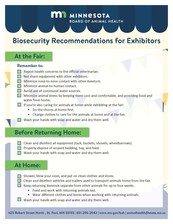Keep reading...
Biosecurity at the Fair: the checklist
We're in the heart of county fair season across Minnesota, and the State Fair is right around the corner! Hopefully you've noticed these signs in the livestock barns at your local fair; if not, ask the fair manager or contact our office for a fresh supply. The checklist is a quick way to make sure you're taking the biosecurity steps necessary to protect your animals and your farm.
Need a refresher on the biosecurity basics specific to the species you raise? Check out our website for a breakdown of best practices by clicking this link.
|
|
 |
Seeking comments on poultry rulemaking
The Board recently published a notice of intent to adopt rules governing poultry and Mycoplasma requirements of turkeys.
The proposed rules are available for viewing, along with the statement of need and reasonableness, on the Board’s rulemaking webpage: https://www.bah.state.mn.us/public-rule-making/.
Under the current rules, testing for Mycoplasma gallisepticum and Mycoplasma synoviae is required for all turkey hatcheries and breeding flocks. Similar rules also apply to poultry dealers, those attending community sales and exhibitions, and those importing turkeys into Minnesota. The rule amendments would restrict the Mycoplasma testing and/or Mycoplasma clean classification requirement to commercial turkey producers, consistent with the requirements for commercial egg-type chicken and commercial meat-type chicken hatcheries and breeding flocks.
Click here to learn how you can submit comments on the proposed rules until 4:30 p.m. on August 21, 2019.
Brucellosis Vaccination Tags and Records
Orange National Uniform Ear-tagging System (NUES) tags, or ‘Bangs’ tags, continue to be available through the Board of Animal Health to Minnesota accredited veterinarians at no cost to them. These tags will be available until the end of the year, or as long as supplies last.
In the future, an alternative to these tags is planned to be available for purchase from authorized tag distributors, possibly with an option to cost share through a USDA program, which the details have not yet been announced. The alternative tags will be radio frequency identification (RFID) tags beginning with an 840 prefix.
Bangs tags may only be applied by accredited veterinarians at the time of Brucellosis vaccination. If the cattle or bison being vaccinated are already officially identified, the existing official identification numbers can be documented and the application of an additional Bangs tag is not required.
The RB-51 vaccine is administered as a full dose of 2 ccs, not a reduced dose, and should be marked accordingly on the record. If vaccines are administered from different serials, please issue a separate Brucellosis vaccination record for each group of cattle receiving each vaccine serial, so that the record makes it clear which vaccine serial each group of cattle received. If more than one vaccine serial is administered to cattle on the same vaccination record, the record must clearly indicate which cattle received each serial.
In addition, if the vaccinated animals are not located at the herd owner’s address, the animal location is required to be documented on the record. This can be done by including the state or federally issued premises identification number in the ‘herd number,’ ‘owner number,’ or ‘farm unit’ field or by completing the public land survey information (township, range, section, district/quarter-quarter). The animal(s) location address may also be captured with the herd owner address if this can be clearly documented. If a state or federal premises number and public land survey information is not known by the herd owner or veterinarian, the ‘herd owner’ address field should contain the herd owner name and the animal location address.
A Brucellosis vaccination record must be fully and accurately completed and submitted to the Board within 14 days.
Upcoming cervid task force meeting
The next meeting of the Cervid Advisory Task Force is set for Tuesday, August 6, 2019 from 1 - 4 p.m. at Cabela’s, 20200 Rogers Drive, Rogers, MN 55374.
The group will be reviewing the two objectives of the task force:
- Develop guidelines for exclusionary fencing which can be approved by the Board to prevent commingling of farmed and wild cervids.
- Provide recommendations to the Board for regulatory changes needed for farmed cervid businesses to remain viable in Minnesota.
|